For many dog lovers, the joy of canine companionship can be overshadowed by allergies or the constant battle against shedding. While no dog is truly 100% “hypoallergenic,” many breeds produce significantly less dander and shed minimally, making them excellent choices for those seeking a cleaner home environment or who suffer from mild allergies. When you combine this low-shedding quality with a manageable medium size, you open up a world of wonderful companions that fit well into diverse living situations.
This guide delves into the characteristics of medium-sized dogs known for their minimal shedding, helping you discover a breed that offers both delightful personality and a reduced impact on your allergies and household chores. We’ll explore what makes these dogs shed less, discuss their unique temperaments, and provide essential tips for living harmoniously with your new furry friend.
Understanding “Low-Shedding” vs. “Hypoallergenic”
The terms “hypoallergenic” and “low-shedding” are often used interchangeably, but it’s important to clarify the distinction. All dogs produce allergens, primarily through dander (dead skin cells), saliva, and urine. There is no dog breed that is completely allergen-free. However, some breeds are often referred to as “hypoallergenic” because they shed very little hair or have hair that traps dander, preventing it from spreading widely throughout the environment.
The key to understanding a dog’s impact on allergies lies in its coat type. Dogs with a single coat or hair-like fur that grows continuously (similar to human hair) tend to shed less compared to breeds with a double coat designed for insulation, which shed seasonally. Less shedding means less dander released into the air and onto furniture, which can significantly reduce allergic reactions for sensitive individuals. For those concerned about allergies or simply preferring a cleaner home, focusing on breeds that “don’t shed too much” is a practical approach.
Why Choose a Medium-Sized, Low-Shedding Dog?
Opting for a medium-sized dog that doesn’t shed excessively offers several distinct advantages, especially for families, apartment dwellers, or first-time dog owners.
Manageability: Medium-sized dogs typically weigh between 20 to 60 pounds and stand 16 to 22 inches tall. This size range is highly versatile. They are generally small enough to be comfortable in apartments but sturdy enough for active families. Their physical presence is less intimidating than large breeds, and they are easier to handle during walks or vet visits. They also require less food and often have smaller waste outputs compared to their larger counterparts.
Activity Levels: Many medium breeds strike a balance between being playful and adaptable. They usually require regular exercise to stay healthy and happy, but their needs are often less intense than those of a large working breed, making them suitable for owners with moderately active lifestyles. This balance makes them great companions for walks, jogs, or simply playing in the backyard without demanding extreme athletic feats.
Reduced Allergen Impact: As discussed, less shedding directly translates to fewer allergens (dander) disseminated throughout your home. This can lead to a significant improvement for individuals with dog allergies, allowing them to enjoy the companionship of a pet without constant sneezing, itching, or respiratory issues. Additionally, less shedding means less dog hair on your clothes, furniture, and floors, simplifying household cleaning and maintenance.
Longevity and Health: While breed-specific health issues exist, many medium-sized dogs tend to have a good lifespan and are less prone to certain size-related ailments (like severe joint problems often seen in very large breeds) compared to both giant and toy breeds. A healthy dog often means a healthier coat, further contributing to minimal shedding.
Top Medium-Sized Dogs That Don’t Shed Too Much
Finding the perfect furry friend involves balancing size, temperament, and shedding characteristics. Here are some of the best medium sized dogs that don’t shed too much, offering a variety of personalities and coat types to suit different preferences.
Standard Poodle
 White Standard Poodle gracefully walking through lush green grass
White Standard Poodle gracefully walking through lush green grass
The Poodle comes in three sizes (Toy, Miniature, and Standard), with the Standard Poodle fitting perfectly into the medium-to-large category. Known for their exceptional intelligence and elegant appearance, Standard Poodles are an excellent choice for those seeking a low-shedding companion. Their distinctive curly coat is a single layer, which means shed hair gets caught within the curls rather than falling out around the house. This unique coat requires regular grooming, including brushing several times a week and professional clipping every 4-6 weeks, to prevent matting and keep it healthy. Despite their sophisticated look, Standard Poodles are highly active, playful, and incredibly loyal, making them fantastic family pets. They excel in dog sports like agility and obedience, thriving on mental and physical stimulation. Their friendly nature makes them generally good with children and other pets, provided they are well-socialized from a young age.
Miniature Schnauzer
 Salt and pepper colored Miniature Schnauzer wearing a pink harness in a vibrant green park
Salt and pepper colored Miniature Schnauzer wearing a pink harness in a vibrant green park
While on the smaller end of the medium scale, the Miniature Schnauzer often fits the bill for those looking for a compact yet sturdy dog that doesn’t shed much. These dogs weigh between 10-20 pounds and stand 12-14 inches tall, making them highly adaptable to various living environments, including apartments. They boast a wiry, double coat, but the outer layer is stiff and designed to shed minimally. Regular grooming, including hand-stripping or professional clipping every 6-8 weeks, along with daily brushing of their distinctive beard and leg furnishings, is crucial to maintain their coat and minimize loose hairs. Miniature Schnauzers are known for their spirited, intelligent, and alert personalities. They are often described as “big dogs in a small package,” possessing a bold and protective nature. Despite their terrier instincts, they are affectionate and thrive on being part of family activities, requiring at least an hour of exercise daily to keep them happy and well-behaved.
Standard Schnauzer
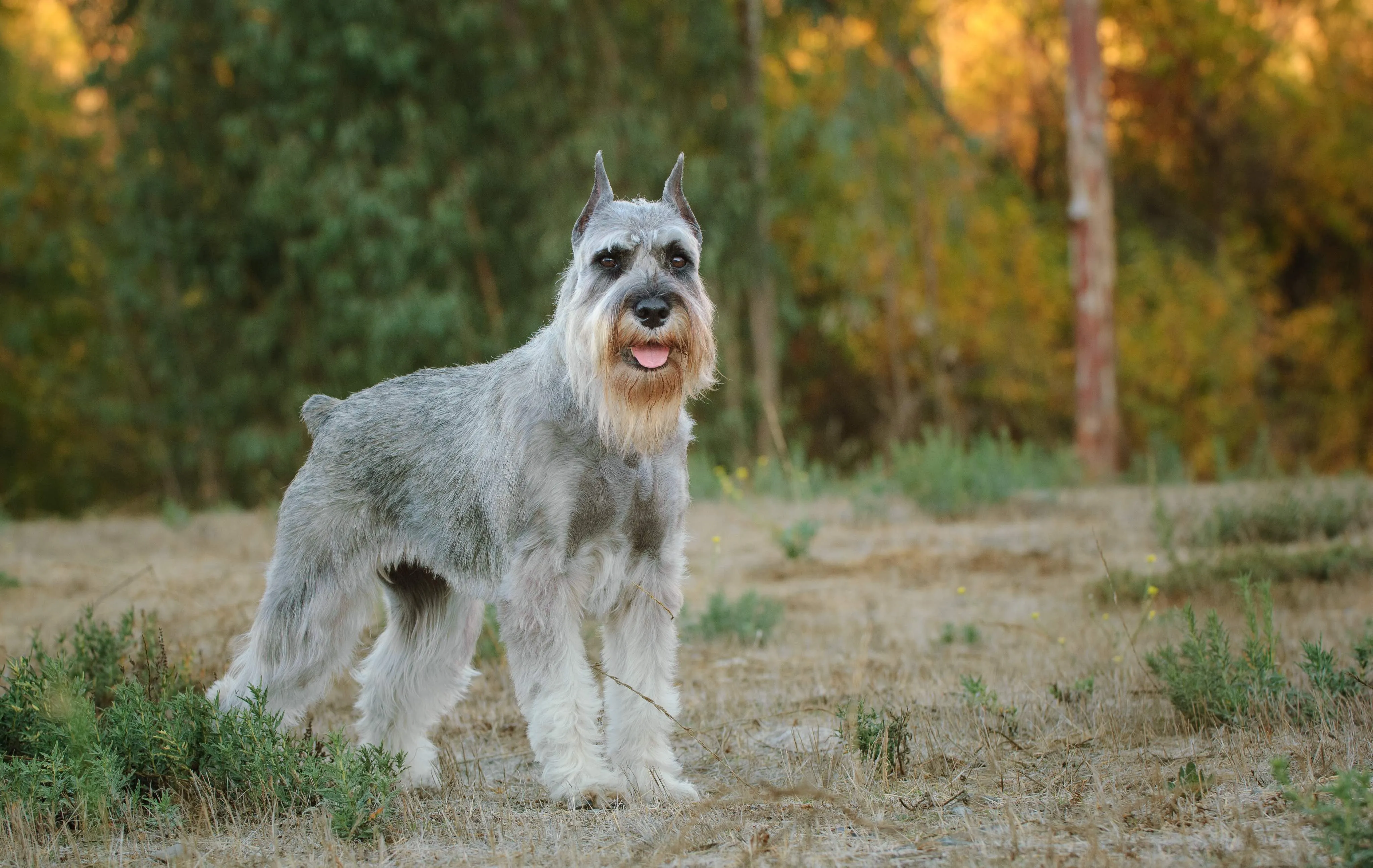 Alert gray Standard Schnauzer standing confidently in a sunlit field
Alert gray Standard Schnauzer standing confidently in a sunlit field
The Standard Schnauzer is the original Schnauzer breed, a robust and versatile working dog that truly embodies the “medium-sized” description, weighing 35-50 pounds and standing 17.5-19.5 inches tall. Like their miniature counterparts, they possess a dense, wiry double coat that sheds very little, making them an excellent choice for those concerned about loose hair. Their grooming needs are similar to the Miniature Schnauzer, requiring regular brushing and professional grooming (hand-stripping or clipping) to maintain coat health and minimize shedding. Standard Schnauzers are intelligent, loyal, and protective, known for their strong personalities and keen watchfulness. They are energetic dogs that thrive on consistent training, plenty of exercise (long walks, playtime, and puzzle toys are ideal), and mental stimulation. With proper socialization, they are devoted family members and can be good with children.
Portuguese Water Dog
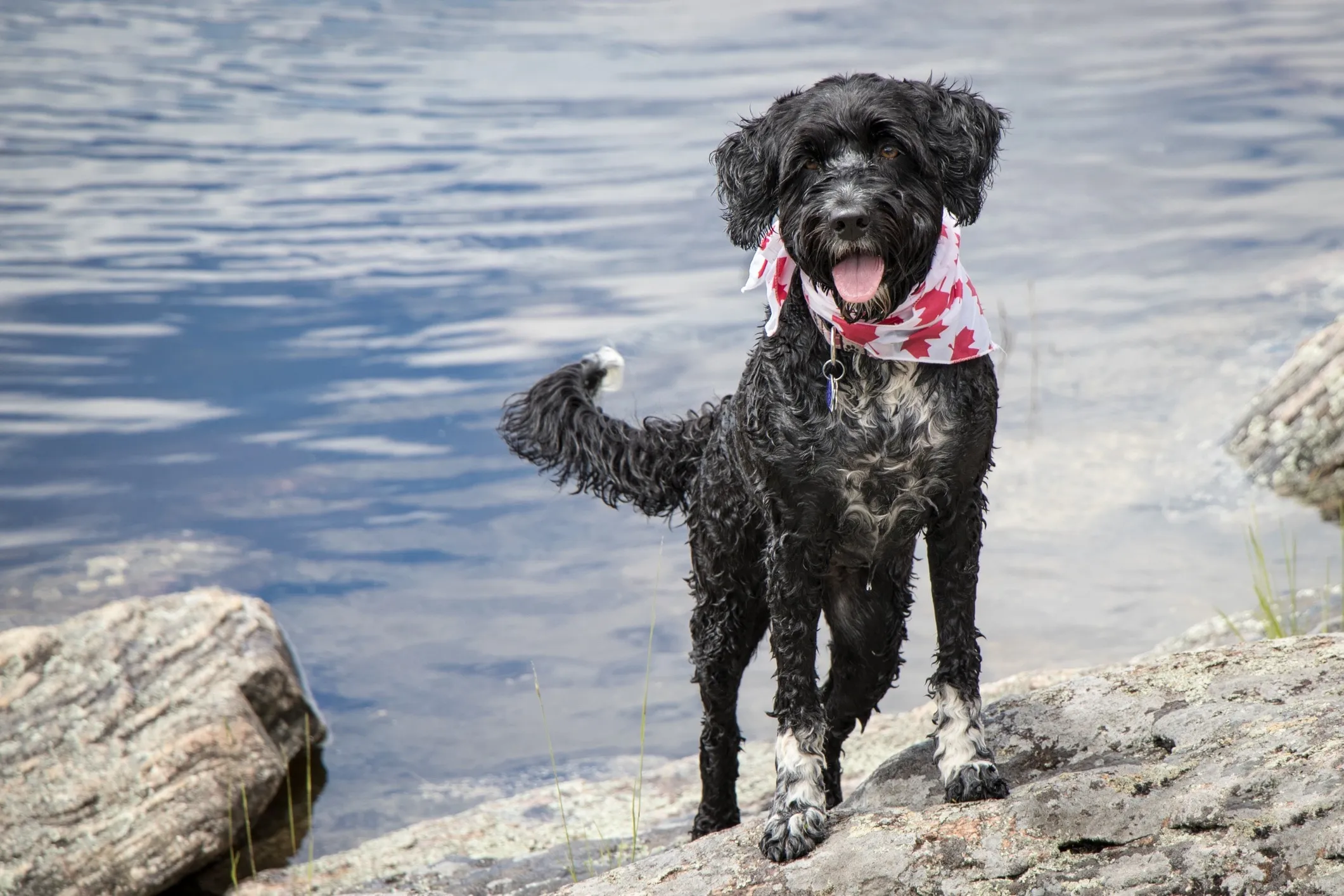 Black and white Portuguese Water Dog wearing a red bandana, standing by the water's edge
Black and white Portuguese Water Dog wearing a red bandana, standing by the water's edge
Originally bred to assist fishermen in Portugal, the Portuguese Water Dog is a highly intelligent and energetic medium-sized breed, typically weighing 35-60 pounds and standing 17-23 inches tall. Their distinguishing feature is a thick, curly, single coat that is virtually non-shedding. This coat is water-resistant and feels more like human hair than fur, trapping any loose dander and hair. However, this non-shedding quality means their coat grows continuously and requires significant grooming. Regular brushing (daily or every other day) is essential to prevent matting, and professional grooming every 6-8 weeks for clipping is a must. Portuguese Water Dogs are known for their adventurous spirit, strong work ethic, and affectionate nature. They are highly trainable and thrive on activities that engage both their minds and bodies, especially those involving water. A great option for active families, they require ample exercise to stay content.
Labradoodle
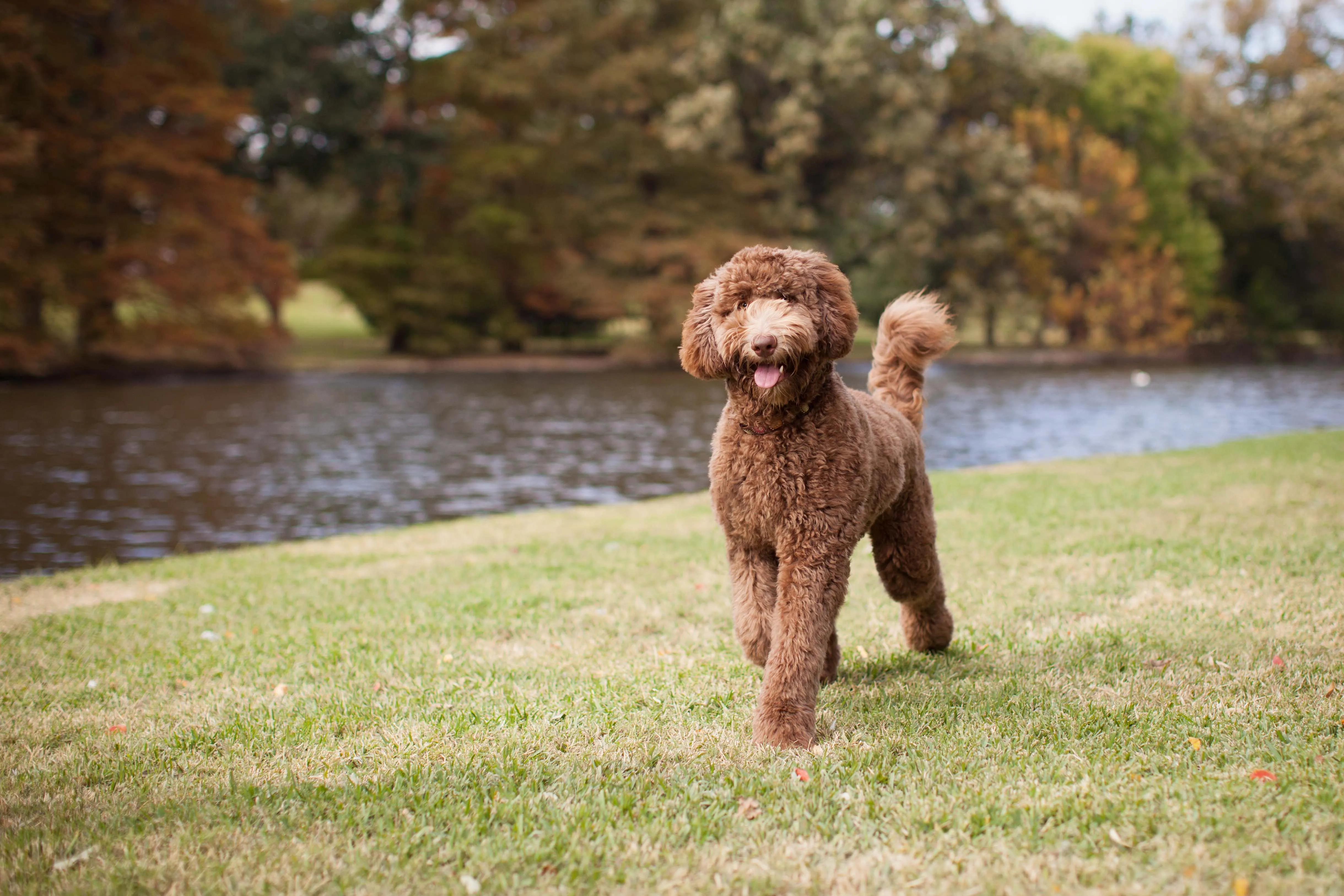 Friendly brown Standard Labradoodle walking happily through a sunny park
Friendly brown Standard Labradoodle walking happily through a sunny park
The Labradoodle, a crossbreed of a Labrador Retriever and a Poodle, was originally developed as a hypoallergenic service dog. While they come in various sizes, the medium Labradoodle typically weighs 30-45 pounds and stands 18-20 inches tall. Their coat type can vary depending on their Poodle and Labrador genetics, ranging from wavy fleece to curly wool, but most Labradoodles are low-shedding. It’s important to note that some Labradoodles may still shed slightly, especially those with more Labrador-like coats. Their Poodle ancestry, however, usually ensures a coat that retains shed hair, making them a good option for allergy sufferers. Regular brushing (several times a week) and professional grooming every 6-12 weeks are necessary to keep their coat healthy and tangle-free. Labradoodles are cherished for their friendly, intelligent, and gentle nature, making them excellent family pets. They are highly trainable and enjoy active lifestyles, benefiting greatly from early socialization.
Goldendoodle
 Affectionate Goldendoodle resting comfortably on a couch with a person in the background
Affectionate Goldendoodle resting comfortably on a couch with a person in the background
Another popular “doodle” breed, the Goldendoodle is a cross between a Golden Retriever and a Poodle. Medium Goldendoodles generally weigh 30-45 pounds and stand 17-20 inches tall. Similar to Labradoodles, their coat can vary, but most inherit the low-shedding qualities of the Poodle, often featuring a wavy or curly coat. They are known for their friendly and affectionate personalities, combining the Golden Retriever’s devoted nature with the Poodle’s intelligence. Goldendoodles require consistent grooming to prevent matting, including frequent brushing with a slicker brush and regular professional trims. They are highly intelligent and eager to please, making them relatively easy to train. These active dogs thrive on companionship and require daily exercise to remain happy and well-adjusted.
Lagotto Romagnolo
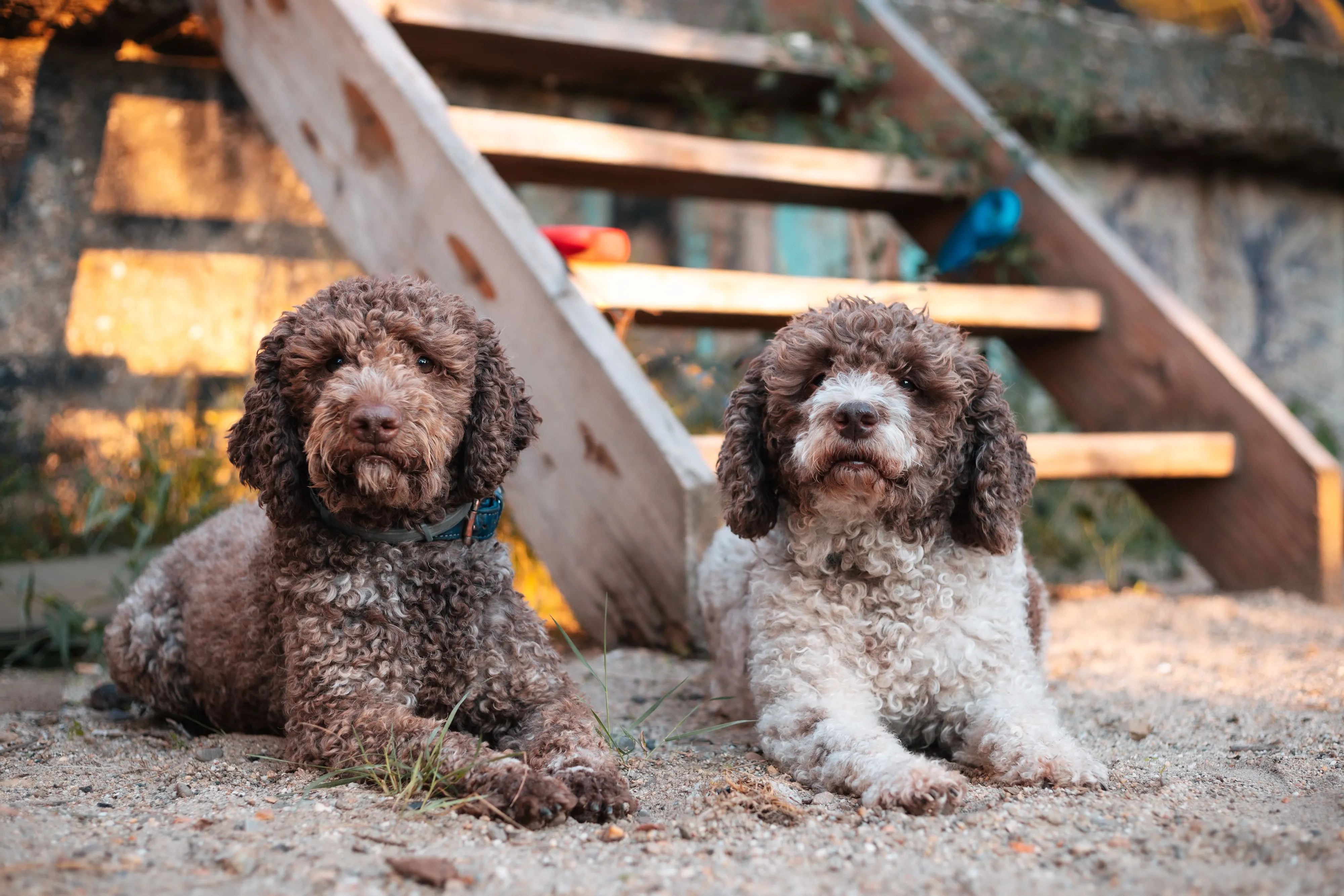 Two attentive Lagotto Romagnolo dogs with curly coats lying in the dirt, looking directly at the camera
Two attentive Lagotto Romagnolo dogs with curly coats lying in the dirt, looking directly at the camera
The Lagotto Romagnolo is an ancient Italian breed originally used as water retrievers and, famously, truffle hunters. These charming dogs are solidly medium-sized, typically weighing 24-35 pounds and standing 16-19 inches tall. Their defining characteristic is a dense, curly, woolly double coat that is virtually non-shedding. This protective coat traps loose hair and dander, making them an excellent choice for allergy sufferers. Their unique coat requires specific grooming: regular brushing (weekly) and occasional clipping, but they should not be brushed too frequently or their curls will lose their structure. Known for their cheerful disposition and keen intellect, Lagotto Romagnolos are active and devoted companions. They are generally good with children and other pets, making them suitable family dogs, but they do require plenty of mental and physical stimulation to prevent boredom.
Irish Water Spaniel
 Profile view of a majestic brown Irish Water Spaniel with a distinctive topknot
Profile view of a majestic brown Irish Water Spaniel with a distinctive topknot
The Irish Water Spaniel is a distinctive and intelligent medium-to-large breed, typically weighing 45-68 pounds and standing 21-24 inches tall. Renowned for their high energy and retrieving prowess, these dogs possess a thick, dense, curly, and oily coat that sheds minimally. The coat is naturally water-repellent, perfectly suited for their original role as water retrievers. While low-shedding, their coat requires diligent grooming to prevent matting. Regular brushing several times a week and professional trimming every 6-8 weeks are essential. Always liver (brown) in color, their unique appearance is matched by a friendly, intelligent, and often clownish personality. Irish Water Spaniels require significant exercise and mental engagement to prevent boredom and ensure they are well-behaved, making them ideal for active individuals or families who enjoy outdoor activities.
Aussiedoodle
 Elegant Standard Aussiedoodle standing gracefully on a sandy beach
Elegant Standard Aussiedoodle standing gracefully on a sandy beach
The Aussiedoodle is a dynamic crossbreed resulting from an Australian Shepherd and a Standard or Miniature Poodle. Medium Aussiedoodles typically range from 30-50 pounds and stand 18-22 inches tall. Like other Poodle mixes, their coat type can vary, but many inherit the low-shedding qualities of the Poodle, making them a popular choice for those seeking a dog that doesn’t shed too much. Regular brushing and professional grooming are vital to manage their wavy or curly coats and prevent tangles. Aussiedoodles are highly intelligent and energetic, thanks to both parent breeds. They require significant mental stimulation and physical activity to stay happy and well-behaved; otherwise, boredom can lead to destructive behaviors. They are typically affectionate, eager to please, and can be great family pets for active households.
Soft Coated Wheaten Terrier
 Joyful Soft Coated Wheaten Terrier dog playfully balancing on a log
Joyful Soft Coated Wheaten Terrier dog playfully balancing on a log
The Soft Coated Wheaten Terrier is a charming Irish breed known for its silky, wavy, single coat that is incredibly soft to the touch and, as the name implies, wheat-colored. These delightful dogs are medium-sized, weighing 30-40 pounds and standing 17-19 inches tall. Their unique coat sheds very little, making them a fantastic option for those seeking a low-shedding companion. However, this coat does require regular maintenance, including daily brushing to prevent mats and tangles, and professional grooming every few months to keep it healthy. Wheatens maintain a high energy level throughout their lives, characterized by their playful “Wheaten Greetin'” (jumping up to greet people). They are friendly, intelligent, and devoted to their families, but they need ample exercise and mental stimulation to channel their terrier energy productively.
Whoodle
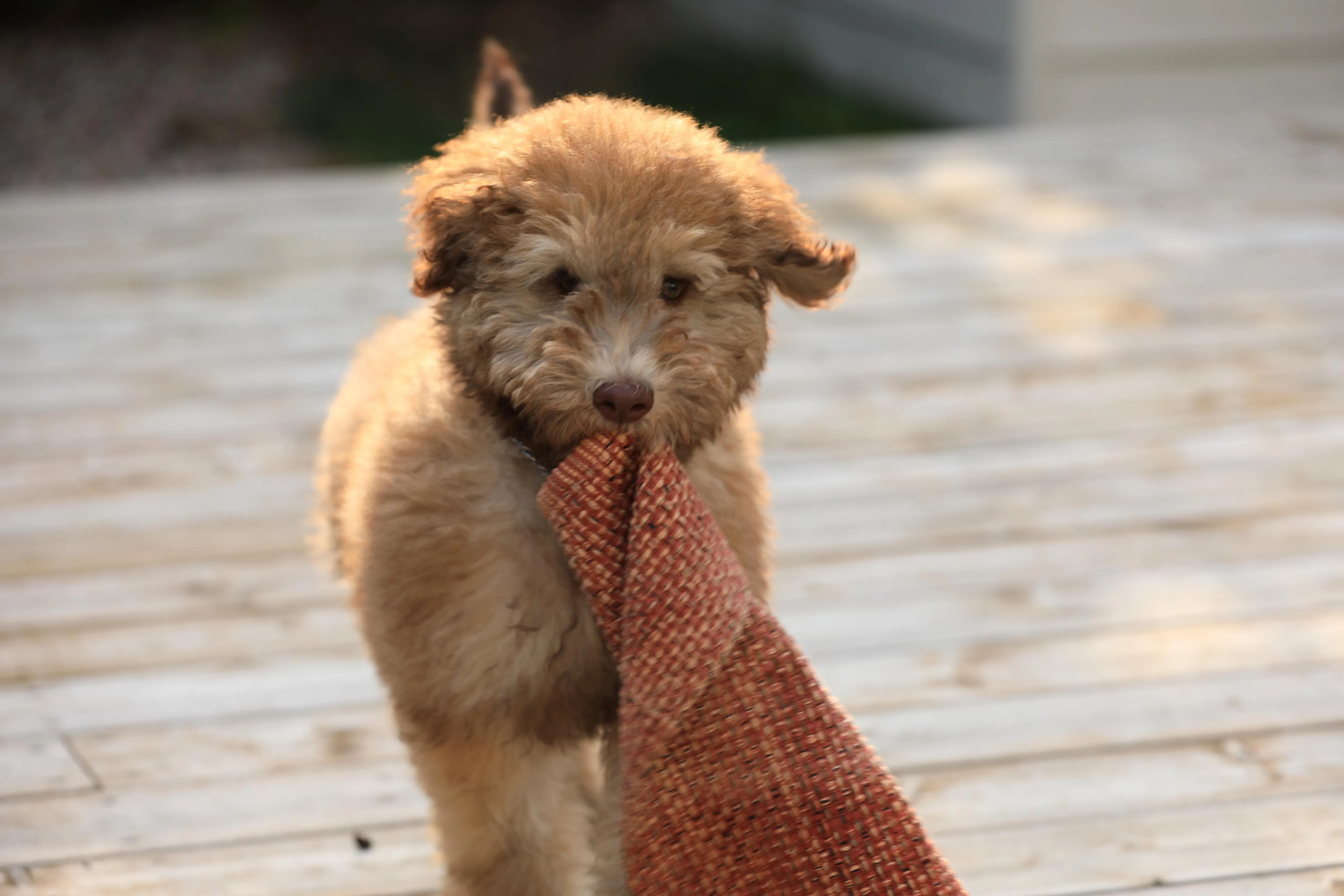 Charming tan Whoodle puppy curiously dragging a washcloth
Charming tan Whoodle puppy curiously dragging a washcloth
A Whoodle is a charming crossbreed between a Soft Coated Wheaten Terrier and a Poodle. This delightful mix typically results in a medium-sized dog, usually weighing 20-40 pounds and standing 17-20 inches tall. Whoodles inherit the low-shedding characteristics from both parent breeds, possessing a soft, wavy, or curly coat that sheds minimally. Their grooming needs involve regular brushing a few times a week and professional trims every 8-12 weeks to prevent matting and keep their coat neat. Whoodles are known for their friendly, affectionate, and intelligent nature. They are eager to please and relatively easy to train, making them suitable for various households. With their playful spirit and loving disposition, Whoodles thrive on companionship and regular exercise.
Bernedoodle
 Large Bernedoodle dog playfully lying in green grass with its tongue out
Large Bernedoodle dog playfully lying in green grass with its tongue out
The Bernedoodle is a crossbreed of a Bernese Mountain Dog and a Poodle. While they come in standard, mini, and tiny sizes, the medium Bernedoodle typically weighs 45-75 pounds and stands 18-22 inches tall, offering a robust yet manageable size. Their coats vary from wavy to curly, and they are generally low-shedding, inheriting this trait from their Poodle parent. Like other Poodle mixes, their “hypoallergenic” quality can vary, but most shed significantly less than a purebred Bernese. Regular brushing (2-3 times a week) and professional grooming every 6-12 weeks are essential to prevent matting. Bernedoodles are known for their friendly, affectionate, and gentle demeanor, making them popular family dogs, especially for homes with children and other pets. They require moderate exercise to stay active and healthy and enjoy being involved in family activities.
Peruvian Inca Orchid (Medium)
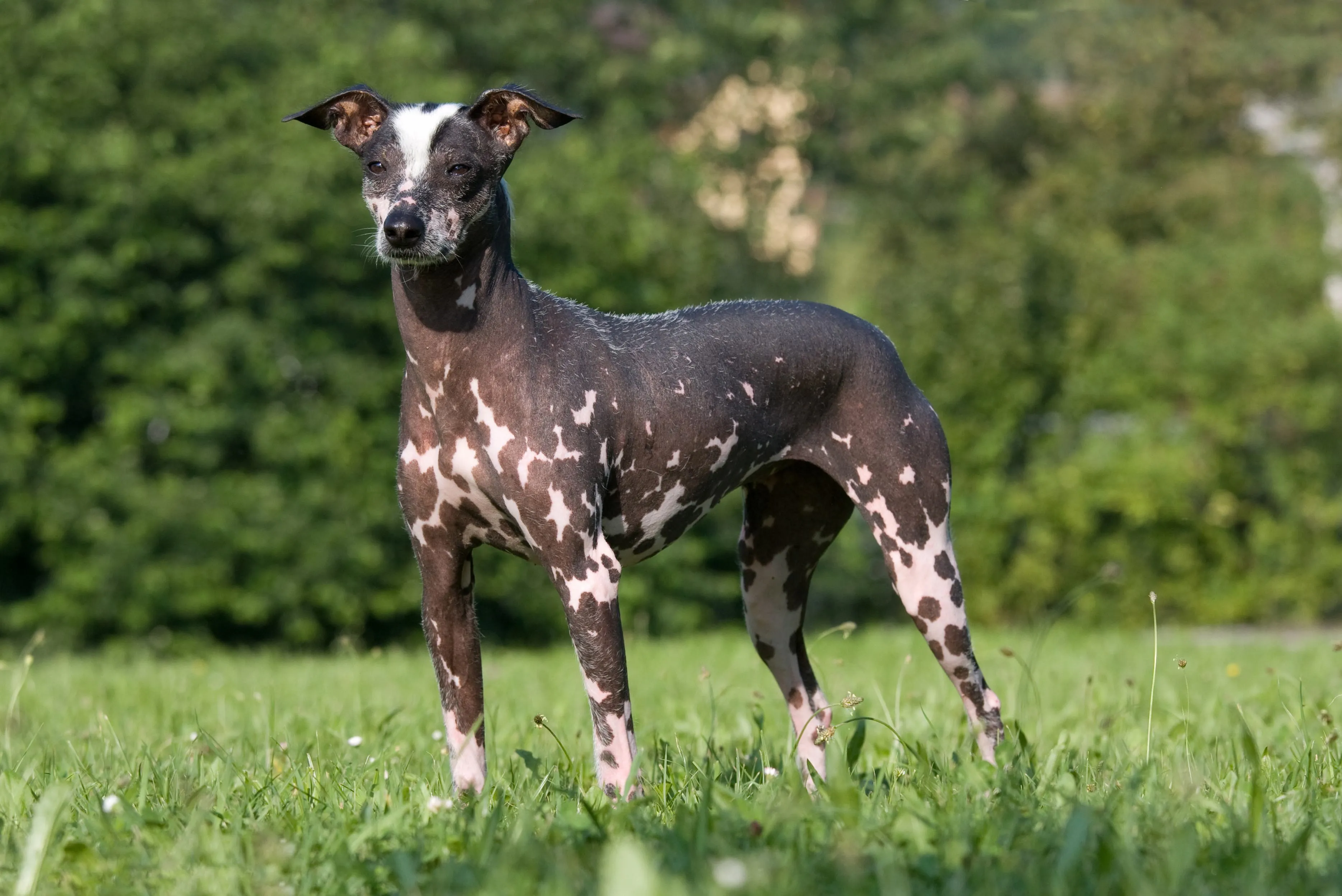 Alert Peruvian Inca Orchid dog standing attentively in the grass
Alert Peruvian Inca Orchid dog standing attentively in the grass
The Peruvian Inca Orchid (PIO) is an ancient and unique breed, known for its striking appearance and low-shedding qualities. While they come in small, medium, and large sizes, the medium PIO typically weighs 20-30 pounds and stands 19.5-22.5 inches tall. They are largely hairless, though a coated variety with a short, single coat also exists, both contributing to their low-shedding nature. The hairless variety requires minimal grooming for shedding, though their skin needs protection from sun and cold and regular moisturizing. The coated variety sheds minimally and requires basic brushing. PIOs are affectionate, loyal, and protective of their families, though they can be reserved with strangers. They are intelligent and agile dogs that benefit from regular exercise and mental stimulation. As the national dog of Peru, they are a rare but fascinating choice for those seeking a unique, low-shedding companion.
Barbet
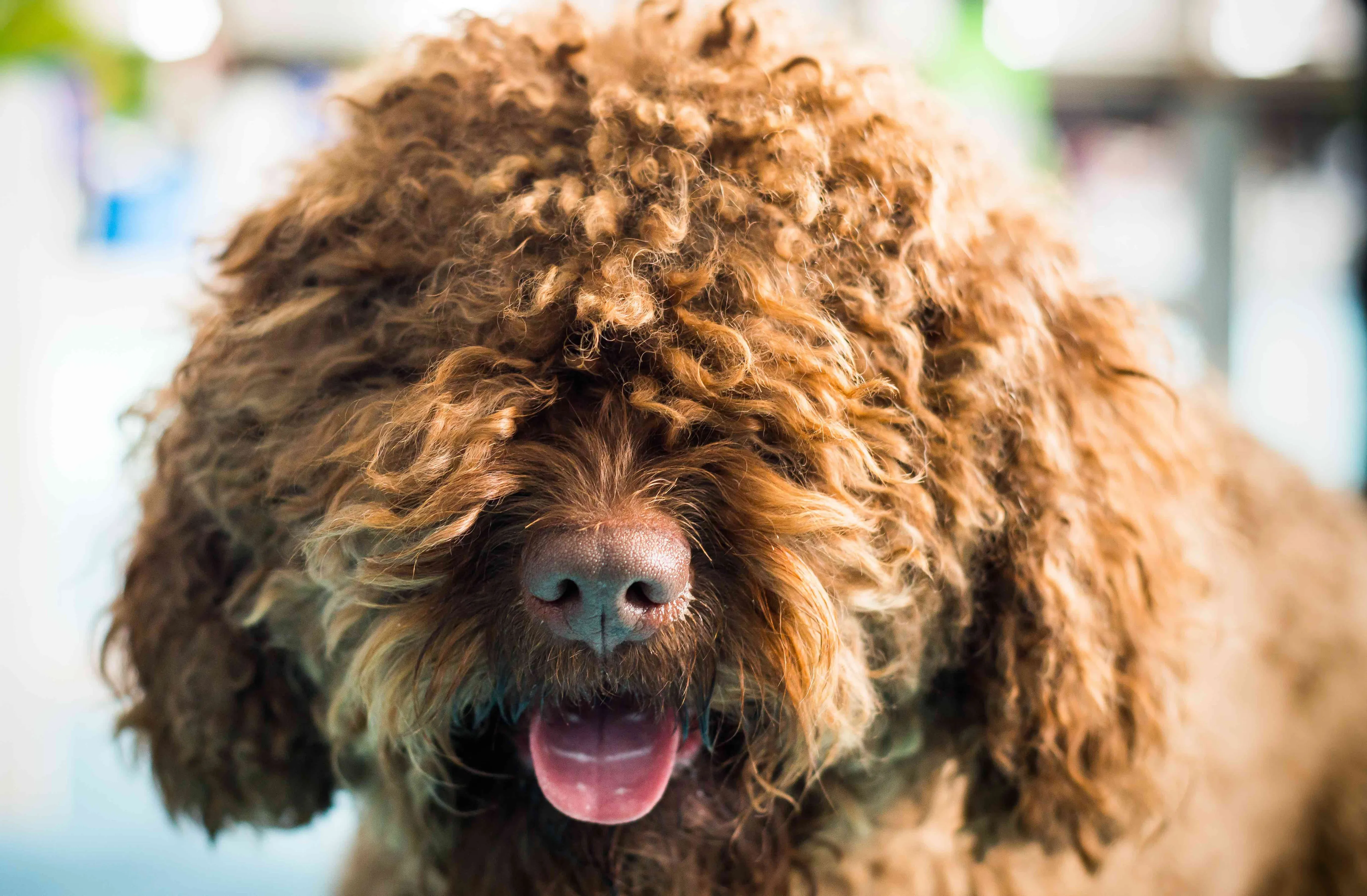 Close-up of a cheerful curly red Barbet dog's face
Close-up of a cheerful curly red Barbet dog's face
The Barbet, pronounced “bar-bay,” is a cheerful French water dog with a characteristic shaggy, woolly coat. This medium-to-large breed typically weighs 35-65 pounds and stands 19-24.5 inches tall. Their dense, curly coat is protective against cold water and, crucially, is low-shedding. The Barbet’s name, derived from the French word barbe meaning “beard,” perfectly describes their distinctive facial hair. While they don’t shed much, their coat requires significant grooming to prevent matting. Regular brushing with a slicker or pin brush two to three times a week, especially after swimming, is essential, along with professional clipping every few months. Barbets are known for their friendly, intelligent, and jovial nature. They love to swim and are active dogs that thrive on mental and physical activities.
Schnoodle (Medium)
 Gray Schnoodle dog looking curiously in a close-up shot
Gray Schnoodle dog looking curiously in a close-up shot
The Schnoodle is a crossbreed that combines two low-shedding breeds: the Schnauzer and the Poodle. This makes them an excellent choice for individuals seeking a dog that doesn’t shed too much. While Schnoodles come in various sizes, medium Schnoodles typically weigh between 20-75 pounds and stand 15-22 inches tall, encompassing a broad range depending on the parentage. Their coat can be curly or wavy, inheriting traits from both Schnauzer and Poodle, but it is consistently low-shedding. Grooming involves regular brushing to prevent tangles and professional trims every 6-12 weeks. Schnoodles are known for their playful, intelligent, and affectionate personalities. They are generally eager to please and can be quite adaptable to different living situations, provided they receive adequate exercise and mental stimulation.
Bedlington Terrier
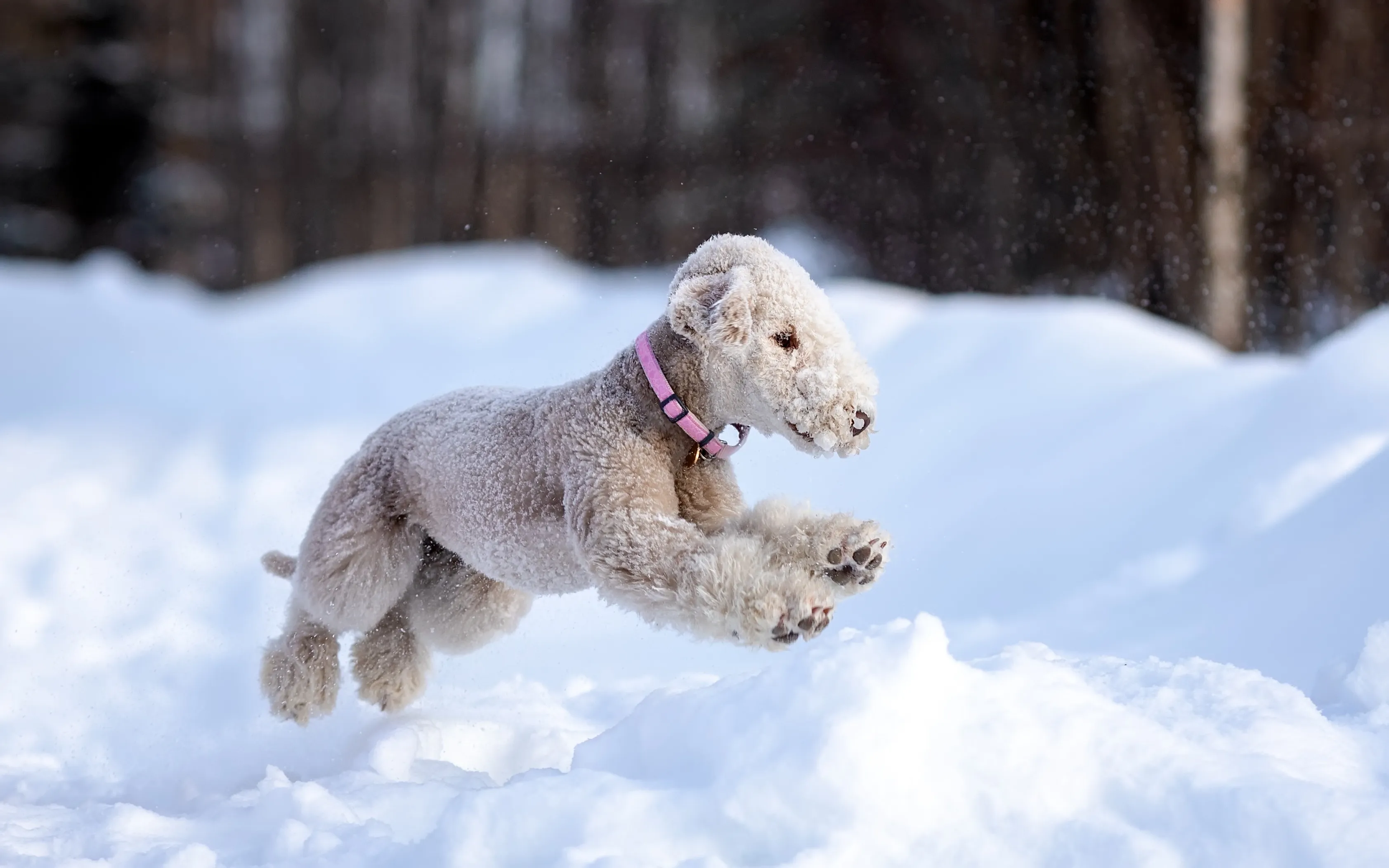 Agile white Bedlington Terrier gracefully running through fresh snow
Agile white Bedlington Terrier gracefully running through fresh snow
Often described as “a lamb in dog’s clothing,” the Bedlington Terrier is a small-to-medium sized dog, typically weighing 17-23 pounds and standing 15-17.5 inches tall. Their distinctive curly, woolly coat has a unique texture and sheds minimally, making them a good option for those concerned about shedding and allergies. This breed is known for its graceful appearance, including a distinctive topknot and pom-pom ear tufts. Despite their delicate look, Bedlington Terriers are robust, energetic, and highly athletic. Their coat requires regular grooming, including brushing a few times a week and professional clipping every 6-8 weeks, to maintain its unique shape and prevent matting. Bedlington Terriers are affectionate and loyal companions who thrive on being close to their people. They need consistent exercise and mental engagement to stay happy and prevent boredom.
Xoloitzcuintli (Standard & Miniature)
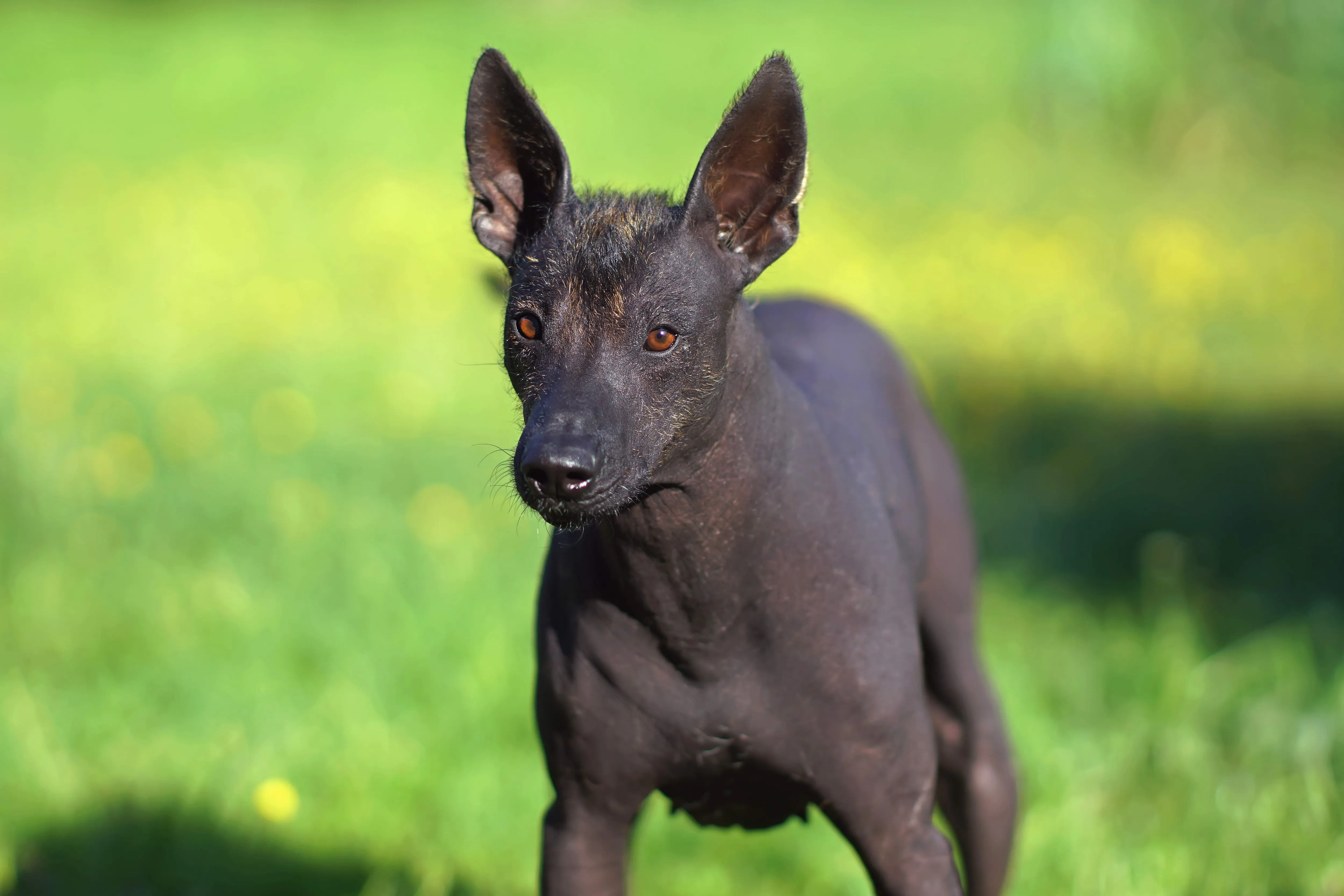 Elegant black Xoloitzcuintli, a Mexican Hairless Dog, standing outdoors in lush green grass
Elegant black Xoloitzcuintli, a Mexican Hairless Dog, standing outdoors in lush green grass
Also known as the Mexican Hairless Dog, the Xoloitzcuintli (pronounced “sho-lo-eets-kweent-lee”) is one of the oldest and rarest dog breeds. They come in three sizes: toy, miniature, and standard. The Miniature Xolo typically weighs 15-30 pounds and stands 14-18 inches, while the Standard Xolo weighs 30-55 pounds and stands 18-23 inches, both fitting the medium-sized criteria. Both the hairless and coated varieties are considered low-shedding. The hairless variety requires no shedding-related grooming but needs skin care (sunscreen, moisturizer, protection from cold). The coated variety has a very short, smooth coat that sheds minimally and requires little upkeep. Xolos are known for being calm, attentive, and loyal companions to their families, though they can be reserved with strangers. They are intelligent and agile dogs that benefit from regular exercise and mental stimulation.
Living Successfully with a Low-Shedding Medium Dog
Bringing a low-shedding, medium-sized dog into your home is a rewarding experience. To ensure a harmonious environment for both you and your canine companion, especially if allergies are a concern, consider these essential tips:
Maintain a Consistent Grooming Routine
Even low-shedding dogs require diligent grooming to keep their coats healthy and minimize the spread of dander. While they don’t leave tumbleweeds of fur around the house, their hair still grows continuously and can matt if not cared for.
- Regular Brushing: Brush your dog several times a week, or even daily for breeds with curly or long coats. This helps remove loose hairs and dander before they fall off, distributes natural oils, and prevents mats. A good quality slicker brush, pin brush, or de-shedding tool (depending on coat type) can make a significant difference.
- Bathing: Bathe your dog every 4-6 weeks using a gentle, dog-specific shampoo. Regular bathing helps wash away dander, saliva residue, and other allergens from their coat. Products specifically designed to reduce pet dander, like Allerpet® Dog Dander Remover, can be very beneficial for allergy sufferers.
- Professional Grooming: Many low-shedding breeds, especially those with continuously growing hair (like Poodles and their mixes), require professional clipping or hand-stripping every 6-12 weeks. Factor this into your budget or learn the techniques to groom your pup at home. This not only keeps their coat tidy but also prevents uncomfortable matting and maintains their low-shedding quality.
Maintain a Clean Home Environment
Minimizing allergens in your home goes beyond just grooming your dog. A clean living space is crucial for managing allergies.
- Vacuum Regularly: Invest in a vacuum cleaner with a HEPA filter and use it frequently on carpets, rugs, and upholstery to pick up stray dander and hair.
- Dust Surfaces: Dust hard surfaces with a damp cloth to trap allergens instead of scattering them into the air.
- Wash Bedding: Regularly wash your dog’s bedding and any blankets or throws they use. If you allow your dog on your bed, wash your own bedding frequently as well.
- Air Purification: Use air purifiers with HEPA filters in rooms where your dog spends a lot of time. Keeping windows open when weather permits can also help ventilate your home.
- Designated “Dog-Free” Zones: Consider establishing certain areas of your home, such as bedrooms, as dog-free zones to provide an allergen-reduced sanctuary for allergy sufferers.
- Hard Flooring: If possible, opt for hard flooring (wood, tile, laminate) over carpets, as carpets can trap allergens more easily.
Prioritize Health and Wellness
A healthy dog with a balanced diet is more likely to have a healthy coat and skin, which can indirectly contribute to reduced shedding and dander. Ensure your dog receives:
- Quality Nutrition: Feed your medium-sized dog a high-quality, balanced diet appropriate for their age, size, and activity level. Good nutrition supports skin and coat health.
- Regular Vet Check-ups: Routine veterinary visits are crucial for overall health, allowing your vet to catch any skin conditions or other health issues that might impact their coat or shedding.
- Parasite Control: Keep your dog free from fleas, ticks, and other parasites, as these can cause skin irritation and lead to excessive scratching and dander production.
Consult with Healthcare Professionals
If you or a family member suffers from dog allergies, it’s essential to consult with your doctor. They can offer personalized advice and discuss various treatment options, which may include:
- Medication: Antihistamines, decongestants, or nasal sprays can help manage allergy symptoms.
- Allergy Shots (Immunotherapy): For severe allergies, a doctor might recommend immunotherapy to gradually build tolerance to allergens.
- Preventative Measures: Your doctor can also provide guidance on other preventative measures to minimize allergic reactions, such as avoiding close contact with your dog’s saliva or urine, which also contain allergens.
Bringing a medium sized dog that doesn’t shed too much into your life can significantly enhance your quality of life, especially for those navigating allergies or simply desiring a cleaner home. These breeds offer the perfect blend of companionship, manageable size, and reduced shedding, allowing you to experience the immense joy of pet parenthood with greater ease. For more information on various companion animals and dog breeds available in India with price, explore our extensive resources. With the right breed choice and a commitment to proper care, you can create a loving and comfortable home for everyone.
References (Original external links were adapted for this section, representing an effort to provide sources if required, though the original article structured them as inline links):
- National Institute of Environmental Health Sciences (NIEHS). “Pet Allergens.”
- PetMD. Breed-specific information for Poodle, Schnauzer, Portuguese Water Dog, etc. (Implicitly cited through breed descriptions).
- The American Kennel Club (AKC). Breed standards and information. (General reference for breed information).
